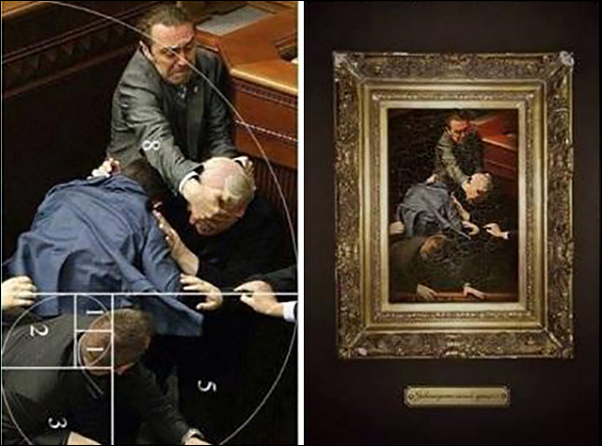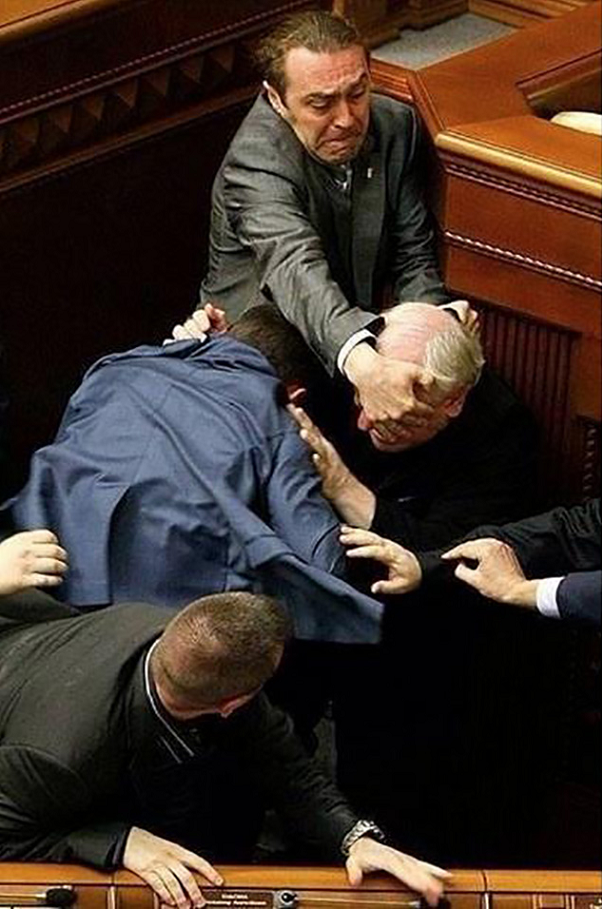[ by Charles Cameron — insight — from the artistic eye via the ayat of the Qur’an and poetic and scientific “readings” to the craft of intelligence analysis ]
.
You might think this was an image taken from some art book by EH Gombrich — Art and Illusion: A Study in the Psychology of Pictorial Representation? — or John Berger — Ways of Seeing, perhaps? — but it’s not. As you might have guessed from my title, or from seeing it elsewhere recently, on BoingBoing, Twitter or wherever.
It’s a journalist’s photo of a brawl in the Ukrainean parliament, where debate is still as lively as it was on the floor of the US House of Representatives in 1798:
or 1858:
A Parliamentary brawl, it would seem, is one mode of the continuation of politics by other means. Or is it just politics as usual?
**
The illustration at the head of this post is indeed “art criticism” in the tradition of Gombrich and Berger, but it’s not an illustration of Old Masterly technique — it’s an artist’s comment on a press photo of a recent brawl, as indicated above, in the Ukrainean parliament. Here’s the photo itself:
**
It’s masterful — and indeed Old Masterful enough that Manzil Lajura posted the photo itself with the two attendant images on FaceBook under the title “Pelea en el parlamento Ucraniano convertido en arte renacentista” — roughly, Brawl in the Ukrainian parliament transformed into Renaissance art..
And yes.
Lajura’s post was then picked up and tweeted by James Harvey:
Someone took a candid photo of a fight in Ukranian Parliament that is as well-composed as the best renaissance art pic.twitter.com/BBhw6rdT3l
— James Harvey (@jamesharveytm) August 6, 2014
And thence onwards into viral multiplicity.
**
So what does this have to do with intelligence — in the analytic sense, or the general sense of intellectual capacity?
Just that it’s a matter of “reading” a surface for more than superficial insight — for “signs” (ayat, the word also used to describe verses in the Qur’an).
What I’m calling “reading” here takes many forms, visual and artistic in this instance, verbal in the case of “closely read” texts — but generalizable as the ways in which we “read” the world. In my post What the Dickens? Symbolic details in Inspire issue 3 exploring the evidence for al-Awlaki’s involvement in the thankfully foiled mail attacks on two Chicago synagogues, I quoted Fazlun Khalid, Islam and the Environment:
The Qur’an refers to creation or the natural world as the signs (ayat) of Allah, the Creator, and this is also the name given to the verses contained in the Qur’an. Ayat means signs, symbols or proofs of the divine. As the Qur’an is proof of Allah so likewise is His creation. The Qur’an also speaks of signs within the self and as Nasr explains, “… when Muslim sages referred to the cosmic or ontological Qur’an … they saw upon the face of every creature letters and words from the cosmic Qur’an … they remained fully aware of the fact that the Qur’an refers to phenomena of nature and events within the soul of man as ayat … for them forms of nature were literally ayat Allah”. As the Qur’an says, “there are certainly signs (ayat) in the earth for people with certainty; and in yourselves. Do you not then see?” (Adh-Dhariat, 51:20, 21).
— and gave some additional details in a more recent update post, Eavesdropping on Twitter — about al-Awlaqi and Dickens.
**
For the mystic, such signs are revelatory of the divine within the natural; for artists, hallmarks of true beauty; for a scientist, for a poet, perhaps, letters in the calligraphy with which the world is written, for jihadists and natsec analysts alike, signals in a significant code — a language used by jihadists in communication, a code analysts must surely learn to read. Here’s Galileo, with a scientist’s view:
Philosophy [nature] is written in that great book which ever lies before our eyes. I mean the universe, but we cannot understand it if we do not first learn the language and grasp the symbols in which it is written. The book is written in the mathematical language, and the symbols are triangles, circles and other geometrical figures without whose help it is humanly impossible to comprehend a single word of it, and without which one wanders in vain through a dark labyrinth.
Recognizing the Fibonacci series / golden ratio spiral, as in the photo of the Ukrainean brawl, is just one of the ways to “read deeper” whatever sights, sounds, texts and images come our way — one of a thousand. William Benzon, blogging at New Savanna today, mentions another. He quotes J. Hillis Miller on Kenneth Burke:
Burke came to Harvard when I was a graduate student and gave a lecture about indexing. What he was talking about was how you read. I had never heard anybody talk about this. He said what you do is notice things that recur in the text, though perhaps in some unostentatious way. If something appears four or five times in the same text, you think it’s probably important. That leads you on a kind of hermeneutical circle: you ask questions, you come back to the text and get some answers, and you go around, and pretty soon you may have a reading.
Who are these folk? They are the kinds of folk who would have been recruited from Yale’s English department in the glory days of OSS and CIA…
But what kind of analysis? Attempting to distinguish “signal” from “noise,” officials at the CIA and Defense Department debate competing methods of data-sifting and weigh the aggressive, “hypotheses-driven” style of interpretation favored by the Pentagon. Probability and risk are continually assessed, and sometimes the talk can sound nearly philosophical. Referring to the search for illegal weapons in Iraq, Defense Secretary Donald Rumsfeld declared on Aug. 5 that “the absence of evidence is not the evidence of absence.”
If such matters arose at a university, they would attract the attention of philosophers of science or even theorists of literature, who study how to tease meaning out of texts. And indeed, the academy has profoundly shaped the rough-and-tumble espionage trade since the founding days of the CIA. In his classic 1987 study, “Cloak and Gown: Scholars in the Secret War, 1939-1961,” Yale historian Robin W. Winks showed how professors took a crucial role in creating and manning the agency and its forerunner, the Office of Strategic Services (OSS). No university played a greater role than Winks’s own. “From Yale’s class of 1943 alone, at least 42 young men entered intelligence work, largely in the OSS, many to remain on after the war to form the core of the new CIA,” Winks notes.
It wasn’t just globe-trotting historians and social scientists who made the leap. As Winks emphasized, Yale’s literature specialists played a key role in shaping the agency’s thinking.
**
The photographer and editor who took and “framed” that image of the Ukrainean parliamentary brawl had an ‘eye” for pattern-recognition — in terms of “form” as much as “content’.






